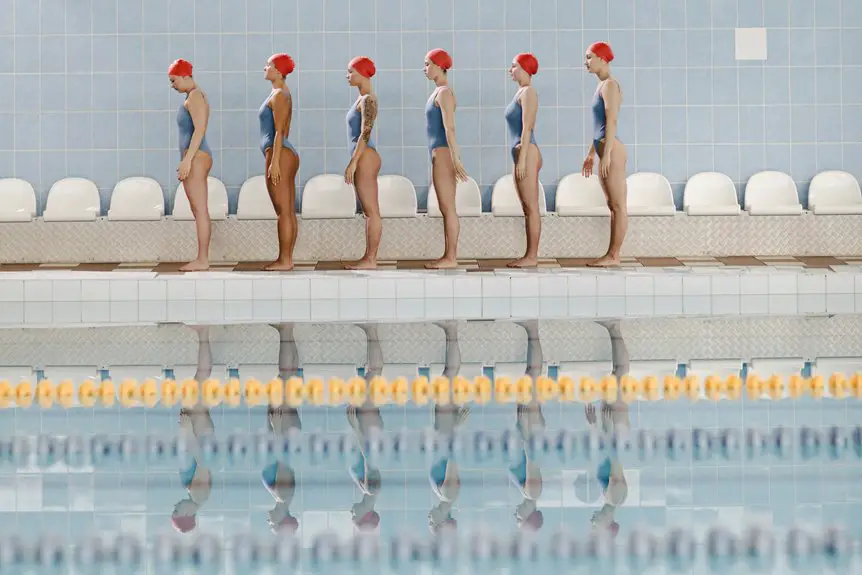Polyamide fabric, while strong and stretchy, isn’t chlorine resistant, so if you swim regularly in chlorinated pools, your suit will fade and lose elasticity faster. Chlorine breaks down polyamide’s fibers, weakening the fabric over time. To protect your swimwear, you’ll want to rinse it thoroughly after each use and consider suits made with more chlorine-resistant materials. Keep this in mind, and you’ll find better ways to extend your gear’s lifespan and perform your best.
Table of Contents
Key Takeaways
- Polyamide fabric offers strength and comfort but has low resistance to chlorine damage over time.
- Chlorine breaks down polyamide fibers, causing fading, loss of elasticity, and fabric weakening.
- Frequent chlorine exposure accelerates deterioration of polyamide swimwear, reducing its lifespan.
- Rinsing polyamide suits with fresh water after swimming helps reduce chlorine damage.
- For frequent pool use, polyester or chlorine-resistant blends are better alternatives to polyamide.
Understanding Polyamide Fabric and Its Characteristics
Polyamide fabric, commonly known as nylon, offers a blend of strength, elasticity, and lightweight comfort that makes it popular in various applications.
When you choose polyamide, you’re getting a material that resists abrasion and stretches without losing shape, which is why it’s favored for activewear and swimwear. It dries quickly and feels smooth against your skin, enhancing comfort during physical activities.
However, polyamide isn’t entirely waterproof; it absorbs a small amount of moisture, which helps with breathability. You’ll also appreciate its durability, as it withstands repeated use and washing.
Polyamide breathes by absorbing moisture and remains durable through repeated use and washing.
Understanding these characteristics helps you make informed choices about your clothing and gear, especially when durability and comfort are key factors in your selection process.
How Chlorine Affects Swimwear Materials
You’ll notice that chlorine chemically breaks down swimwear fibers, weakening their structure over time.
Different materials handle this exposure in various ways, with some fabrics lasting longer than others.
Understanding these differences helps you choose swimwear that stands up better to frequent pool use.
Chlorine’s Chemical Impact
Although chlorine helps keep pools clean, it can quickly break down swimwear fabrics, causing them to lose their shape and color.
When you expose polyamide or other fabrics to chlorine, the chemical attacks the polymer chains, weakening the fibers. This leads to thinning, stretching, and fading over time.
Chlorine’s oxidizing nature disrupts molecular bonds, which compromises the fabric’s elasticity and strength. You might notice your swimsuit becoming rougher or less snug after repeated swims.
The damage isn’t always immediate, but consistent exposure accelerates fabric deterioration.
To protect your swimwear, it’s essential to rinse it thoroughly with fresh water right after swimming. Understanding chlorine’s chemical impact helps you take better care of your gear and extend its life in chlorinated pools.
Material Durability Differences
Different swimwear materials respond to chlorine exposure in varying ways, affecting their durability and lifespan. When you choose swimwear, understanding how fabrics like polyamide, polyester, and Lycra handle chlorine helps you pick longer-lasting gear. Polyamide tends to degrade faster, losing elasticity and color, while polyester holds up better. Lycra offers comfort but can weaken quickly with repeated chlorine contact. Here’s a quick comparison:
| Material | Chlorine Resistance | Durability Impact |
|---|---|---|
| Polyamide | Low | Fades, weakens elasticity |
| Polyester | High | Maintains color & strength |
| Lycra | Moderate | Soft but loses stretch |
Knowing these differences lets you care for your swimwear properly and swim smarter.
The Chlorine Resistance of Polyamide Fabric
You’ll find that polyamide fabric offers strong chemical durability, making it a popular choice for swimwear.
However, repeated chlorine exposure can still break down its fibers over time.
Let’s explore how this impacts the fabric’s performance and lifespan.
Polyamide’s Chemical Durability
When you expose polyamide fabric to chlorine, its chemical structure faces challenges that can affect durability.
Polyamide, made from long chains of repeating amide groups, is naturally resilient but susceptible to chemical reactions with chlorine. Chlorine can break some molecular bonds within these chains, weakening the fabric’s strength over time.
However, polyamide’s tightly packed molecular arrangement offers moderate resistance, slowing chlorine’s penetration compared to other fibers. This means polyamide won’t instantly degrade but does experience gradual chemical wear with repeated chlorine exposure.
To maintain its durability, you need to rinse polyamide swimwear immediately after use and avoid prolonged contact with chlorinated water.
Impact of Chlorine Exposure
Understanding how chlorine affects polyamide fabric helps you gauge its real-world performance in pools and other chlorinated environments.
When you expose polyamide to chlorine, the fibers can degrade over time, causing loss of strength and elasticity. Chlorine attacks the molecular bonds in the fabric, leading to color fading and increased wear.
While polyamide is more resistant than natural fibers, it’s not completely impervious. If you swim frequently in chlorinated water, you’ll notice your polyamide swimwear may become less durable and lose its shape faster than non-chlorinated fabrics.
To extend the lifespan of your polyamide gear, rinse it thoroughly with fresh water after each swim. This simple step reduces chlorine damage and helps maintain the fabric’s integrity and appearance over time.
Comparing Polyamide to Other Common Swimwear Fabrics
Although polyamide offers notable chlorine resistance, you might wonder how it stacks up against other popular swimwear fabrics like polyester and Lycra.
Polyester generally outperforms polyamide when it comes to chlorine resistance, maintaining its shape and color longer under frequent exposure.
Lycra, known for its exceptional stretch and comfort, tends to degrade faster in chlorinated water, losing elasticity over time.
While polyamide strikes a good balance between durability and flexibility, it may not last as long as polyester in heavily chlorinated pools.
However, polyamide often feels softer and more comfortable against your skin compared to polyester’s sometimes stiffer texture.
So, your choice hinges on what you prioritize: durability, comfort, or stretch.
Understanding these differences helps you pick swimwear that suits your swimming habits best.
Tips for Prolonging the Life of Polyamide Swimwear
To keep your polyamide swimwear looking and feeling its best, you’ll need to take some simple but effective steps.
After every swim, rinse your suit thoroughly with cold, fresh water to remove chlorine and salt. Avoid using harsh detergents; instead, wash it gently with a mild soap or specialized swimwear cleaner.
Don’t wring out your suit—press it lightly to remove excess water. Always dry your swimwear flat in a shaded area, away from direct sunlight, which can degrade the fabric.
Avoid sitting on rough surfaces to prevent snags. Rotate between different suits if you swim often to reduce wear.
Following these tips will help maintain your polyamide swimwear’s elasticity, color, and overall durability, letting you enjoy it longer without sacrificing comfort or style.
Choosing the Right Swimwear for Frequent Chlorine Exposure
Taking care of your polyamide swimwear can extend its life, but choosing the right suit makes an even bigger difference when you swim regularly in chlorinated pools.
Look for swimwear labeled as chlorine-resistant or made with blends that include PBT or polyester, as these materials hold up better against chlorine damage than pure polyamide.
Consider suits with tighter weaves and higher-quality fabrics designed specifically for frequent use in pools. Avoid suits with delicate finishes or embellishments that chlorine can quickly degrade.
Also, pick colors that resist fading to keep your swimwear looking fresh. Investing in the right swimwear saves you money and frustration down the line, letting you enjoy your swimming sessions without worrying about quick wear and tear.
Frequently Asked Questions
Can Polyamide Fabric Be Recycled or Is It Biodegradable?
You can recycle polyamide fabric, but it’s not biodegradable. It breaks down slowly in nature, so recycling helps reduce waste. Make sure to check local facilities that accept synthetic fabrics for proper recycling options.
Does Polyamide Fabric Dry Faster Than Other Swimwear Materials?
You’ll find polyamide fabric dries faster than many traditional swimwear materials because it’s lightweight and wicks moisture efficiently. This means less wait time between swims and more comfort when you’re on the go.
Is Polyamide Fabric Safe for Sensitive Skin?
Like a gentle breeze on a calm day, polyamide fabric is usually safe for sensitive skin. You’ll find it soft and smooth, but always patch-test first to avoid irritation, since everyone’s skin reacts differently.
How Does Polyamide Fabric Hold up in Saltwater Compared to Chlorine?
You’ll find polyamide fabric holds up better in saltwater than chlorine. Saltwater is less harsh, so your gear lasts longer, while chlorine can break down fibers quicker, causing fading and reduced elasticity over time.
Can Polyamide Swimwear Be Safely Machine Washed?
You might worry machine washing could damage polyamide swimwear, but you can safely do it on a gentle cycle with cold water. Just avoid harsh detergents and never use bleach, so your suit lasts longer.
- Can You Tumble Dry Polyamide - July 1, 2025
- Can You Machine Wash Polyamide - July 1, 2025
- Can You Iron Polyamide - July 1, 2025






